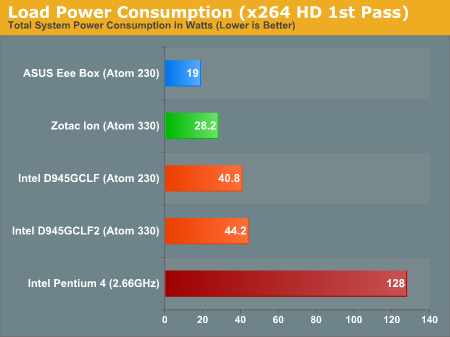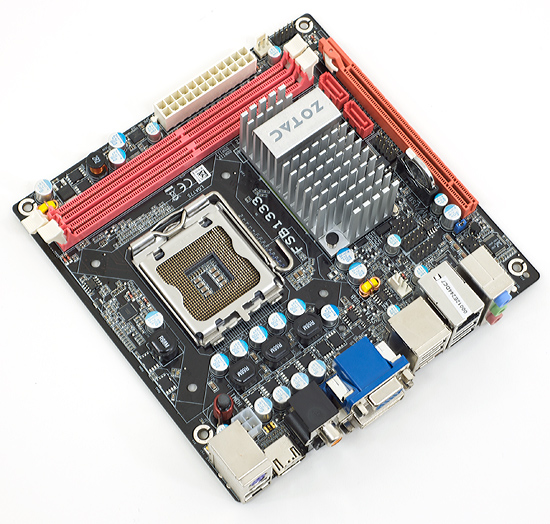Zotac's Ion: The World's First mini-ITX Ion Board
by Anand Lal Shimpi on May 12, 2009 12:00 AM EST- Posted in
- GPUs
Power Consumption
Compared to the Intel Atom boards, the Zotac wins out - it doesn't have to use a bulky desktop power supply which isn't as efficient at these low power draws. Compared to something more similar however, like the Atom 230 based ASUS Eee Box with its own external DC power supply, we see that the Zotac Ion does draw more power than Intel's Atom platform. I'm not sure how much more this could be cut down when used in a netbook/notebook, but that could be a deal breaker for more mobile versions of Ion.


Final Words
What do I think of the world's first mini-ITX Atom Ion motherboard? I like it. Zotac did a good job of delivering pretty much everything I'd want in a board like this, going even further than expected and offering a solution with an external power brick. I don't like the external power option from a long-term replacement standpoint, but I do appreciate its convenience. My only complaint is the price, at $189 it's a bit expensive for the performance you get but I do concede that there are some benefits in the convenience department. All you need to add is memory and some sort of storage and you're good to go, you'll have a system that's easily capable of playing back high definition content (not to mention very power efficient while doing it).
The general application performance of the Zotac Ion isn’t actually any better than the Intel D945GCLF2. It’s when you look at GPU-enabled applications that the Ion holds any real performance benefit. Blu-ray playback or 3D gaming are its real performance strengths; if you plan on doing neither then the platform isn’t very useful.
I did try some CUDA applications on the Zotac Ion board and they were definitely faster than using the CPU alone. While our x264 test managed around 12 fps on the Zotac Ion, using Badaboom I was able to encode at just under 20 fps.
When it comes to the Atom processor, at least on the desktop, there’s simply no reason to opt for the single-core model. Most tasks are so completely CPU bound on Atom that any increase in processing power is instantly noticeable. The Atom 330 ends up being faster than even a 1.6GHz single-core Celeron 420 in many tests, particularly video encoding and 3D rendering, while falling behind in other applications like WinRAR and even our general SYSMark tests. With enough cores, the Atom architecture is efficient in delivering good floating point performance it seems. Branchy integer code however favors the speculative execution engines of more conventional desktop microprocessors. The only reason I see the single-core Atom being of any use is if you're building a cheap file server, but otherwise the Atom 330 is so much faster across the board that it's more than worth it. Hyper-Threading definitely helps the Atom 230, but there's no replacement for another fully functional core. The added power consumption is nothing serious.
If you do need more CPU power, Zotac actually offers an LGA-775 version of the board but it of course requires a standard power supply:

Power consumption on the Zotac Ion is appreciably low, thanks in part to its 90W DC power supply. Compared to ASUS’ Eee Box however, the Ion system does use nearly 50% more power under load.
Everyone seemed to want an Ion based motherboard after NVIDIA first showed off its reference platform. Acer delivered the first Ion system, but it looks like Zotac is delivering what we all wanted from the start. Now it's time to see how people start using these things....










93 Comments
View All Comments
bobvodka - Wednesday, May 13, 2009 - link
While I know it's only at the RC stage, it might be intresting to see how this plays with Win7, if only as a nod to the future and with regards to how it performs against XPlemon8h8ead - Wednesday, May 13, 2009 - link
Thanks for a good job in optimizing control over the environment. It is not easy to create apples-to-apples tests.I would have been interested in seeing the same H/W configurations running one of the popular Linux distros (E.g. Ubuntu). It has been my observation that the Linux kernel multithreads more efficiently than Windows but those were purely compute-bound applications that I was comparing and the benchmarks are 8 years old on very dated H/W platforms (obsolete). I realize that both Windows and Linux kernels have improved vastly since then.
Is your HTPC speced out here anywhere? Just curious.
sysdump - Wednesday, May 13, 2009 - link
I want to see HD H264 content decoded using CUDA! To see if it can handle non DXVA compatible videos.mvrx - Wednesday, May 13, 2009 - link
I've been using an Atom 330 system as a DD-WRT router.. cost me only $150 and is probably 15x faster than any Dlink or linksys on the market.. People really need to pay attention to this possibility.mindless1 - Wednesday, May 13, 2009 - link
Presumably you're comparing against Dlink and Linksys consumer grade routers, that are meant for light use. In such a scenario why would it need to be 15X faster and had you done latency tests that quantify the difference? Checking latency on a router running DD-WRT I find the router latency insignificant compared to the rest of the nodes along a typical connection, and that when the router is even doing QOS concurrent to P2P transfers.I'd think a board like this to be quite overkill for mere routing, it might be nice though to have a few more features possible like DNS caching, web proxy, advanced firewall rules, web/mail server.
JoKeRr - Wednesday, May 13, 2009 - link
For $80 with 3 SATA ports and add in some ram and 3 hard disks, this will make a decent NAS file server with linux installed.I use a PS3 in the living room, it used to be a old mac mini. Right now I definitely miss the iPhone remote with iTune in the mac mini. PS3 is great for movies, but for not so with web content. I use PS3 media server to stream movies from my PC to the PS3, it also performs transcoding on the content that PS3 doesn't recognize (mkv). My desktop is P4 3.0C overclocked to 3.5GHz, and it has no problem transcoding mkv movies in 720p resolution (max bit rate I saw was around 15Mbps), I would really like to know how the dual core atom performs on the transcoding front with PS3 media server. If it works well, it will be a very nice compliment to the PS3 system.
Thank you!
NullSubroutine - Saturday, May 16, 2009 - link
I thought I'd like to throw out that that with MKV files you can mux them (like with tsMuxer) to MT2S files which can then be renamed to MP4 to play on PS3.Muxing takes less than a minute usually and doesn't convert the video just takes it out of the MKV container file.
It may be easier to do this with your files than have them transcode on the fly.
ViRGE - Tuesday, May 12, 2009 - link
If only it had component out. The HDMI port is nice, but I had a RP-CRT; I'd love to replace my HTPC box with something like this, but the lack of component out is a killer.moozoo - Tuesday, May 12, 2009 - link
I believe the ION platform supports CUDA.Please run some CUDA benchmarks and those H264 video encodings using BadaBOOM on this motherboard.
The ION chipset (MCP79) has very low latency between the GPU and the main memory. This makes it possible to perform audio functions on the GPU.
See http://forums.nvidia.com/index.php?showtopic=92290">http://forums.nvidia.com/index.php?showtopic=92290
JarredWalton - Tuesday, May 12, 2009 - link
From the conclusion:"I did try some CUDA applications on the Zotac Ion board and they were definitely faster than using the CPU alone. While our x264 test managed around 12 fps on the Zotac Ion, using Badaboom I was able to encode at just under 20 fps."